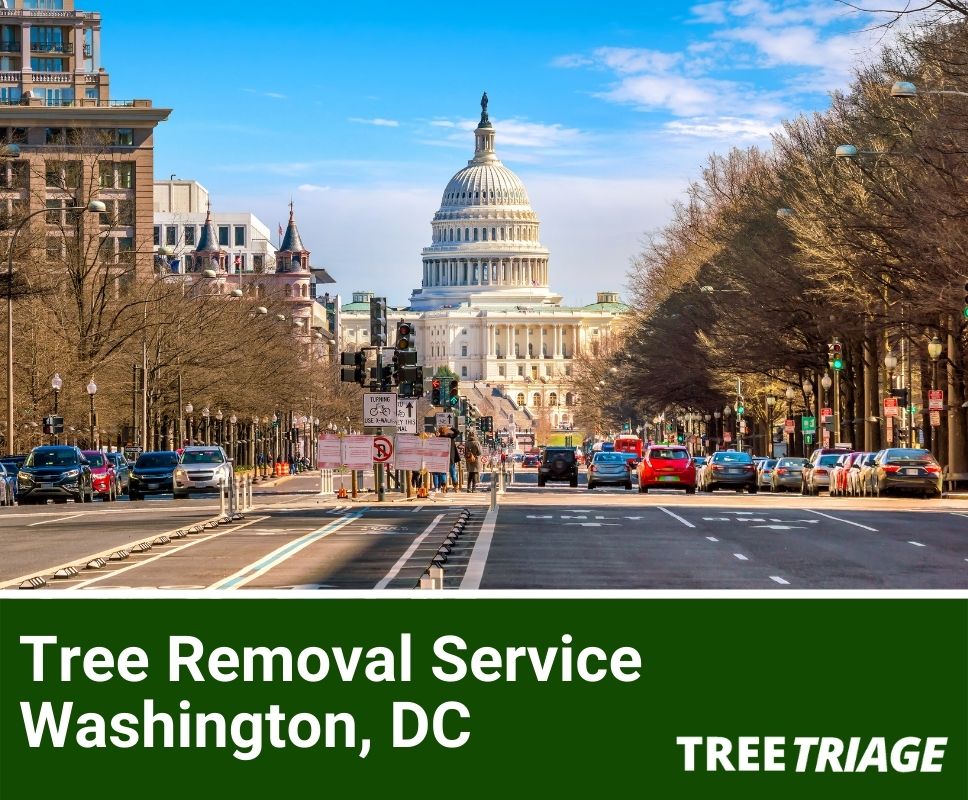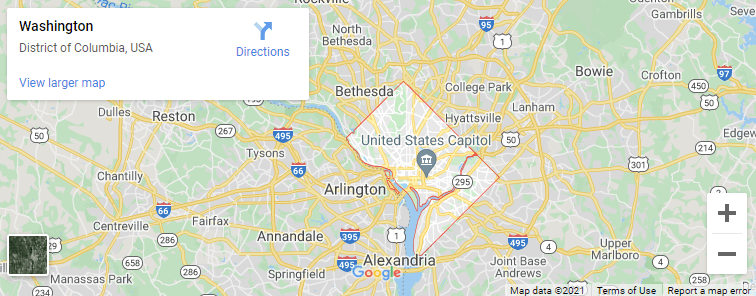Contents (Click To Jump)
- 1 What Are the Most Common Tree Issues in Washington DC?
- 2 Does the City of Washington DC Provide any Assistance in Tree Removal Problems?
- 3 Who Is Responsible for Fallen Tree Removal in Washington DC?
- 4 How Does the Soil Affect Trees in Washington DC?
- 5 Does Weather Affect Tree Health In Washington DC?
- 6 What If Dead Trees Are Near Power Lines In Washington DC?
- 7 How Much Does Tree Removal Usually Cost in Washington?
What Are the Most Common Tree Issues in Washington DC?
Known as the City of Trees or City within a Park, Washington DC is home to an impressive urban forest. However, efforts to maintain the growing number of trees are a challenge. Many of the city’s residents are active participants in keeping the urban forest healthy, and trees are inspected to determine whether removal is indeed necessary. Sometimes, the situation may call for a tree to be removed. These are the most common issues that affect trees in Washington DC:
Storms
Storms with high winds or hail wreak havoc on trees. Even large trees can be toppled or suffer severe damage due to storms. Downed trees or those that pose a threat to structures and people must be removed. Trees severely damaged by the loss of one or more large limbs may not be able to recover.
Diseases
Trees in all areas are subject to disease, and Washington DC is no exception. Fungal and root disease can damage trees beyond repair, if signs are not identified early.
Pests
Insects are a major danger for trees, since they target entire species of trees once they infest an area. Exotic forest insects (due to high rates of commerce) are a common issue for Washington DC’s urban forest. Exotic bark and ambrosia beetles are the biggest culprits in the area.
Neglect
While the tree canopy in many areas of Washington DC is thriving, some areas are mostly barren. Northeast neighborhoods like Trinidad and Montello Avenue only have newer trees planted within the last few years. This disparity doesn’t reflect the efforts of the forestry division today. Instead, the neglect that occurred during budget cuts of the 1990s meant that few trees were planted in poorer neighborhoods, and many died due to poor care and no maintenance.
Does the City of Washington DC Provide any Assistance in Tree Removal Problems?
Public tree removal in Washington DC can be a complicated process. The tree permitting and removal process is overseen by the Urban Forestry division of the Department of Transportation. In an effort to increase the tree canopy to 40% by 2032, many public trees are protected, whether they’re located on private or public property. This means that anyone wishing to remove a tree will likely need to obtain a permit and wait for approval before removing any tree.
Sidewalk trees are considered the city’s responsibility and are maintained (and removed when necessary) by city arborists. While trees located on private property or designated parking spaces adjoining private property are considered the homeowner’s responsibility, the city has an Income Contingent Hazardous Tree Mitigation Program designed to provide assistance with the removal of hazardous trees.
Who Is Responsible for Fallen Tree Removal in Washington DC?
Washington DC is unique in that it has dedicated park space along practically all streets. This space, adjoining private property and sidewalk space, is home to public trees that are the homeowner’s responsibility to maintain. Public trees located in the sidewalk space are the responsibility of the city. As a resident of Washington DC, there is a process to follow for practically every type of tree removal.
If you’re a homeowner?
Homeowners in Washington DC often have a mix of public and private trees located on their property. Property owners can plant trees on private property or request trees from the forestry division to improve the city’s tree canopy. When a public tree is located on your property or adjoining parking property, you’re responsible for removal. When a private tree is located on your property, you’re also responsible for removal. However, permits must be obtained for the following situations:
- The planting, pruning, or removal of a tree within the public right-of-way
- When your construction project will impact a public tree
- The removal of a Special Tree (any tree between 44″ and 99.9″ in circumference). If a special tree is considered nonhazardous by a city arborist, then a fee of $55 dollars per inch of circumference is required for the application to be issued.
- A construction project that affects Special Trees
- The removal of a Heritage Tree (any tree with a circumference greater than 100″). These trees will only be removed if considered hazardous by a city arborist.
- A construction project that affects Heritage Trees
Homeowners that meet income guidelines may obtain help with hazardous tree removal on private property if they are eligible for the Income Contingent Hazardous Tree Mitigation Program.
If you’re a renter?
As a renter, you’re not responsible for trees on the property you rent. If a hazardous tree is located on your rental property, it’s best to contact your landlord for assistance. However, if you have difficulty getting in touch with your landlord or getting the landlord to take action, Washington DC’s interactive urban forestry approach can be an advantage. Reporting hazardous trees to the forestry division by online form or by phone can help speed up the process of inspection and removal.
If you’re a landlord?
A landlord is the property owner and is therefore subject to the same rules as a homeowner when it comes to tree removal responsibilities.
If you’re a neighbor?
Since your neighbor’s tree isn’t your responsibility, the best course of action is to simply talk to them about the problem tree. While you can check the city map to determine if the tree is a public tree, many public trees fall under the homeowner’s responsibility. If your concern is about your construction project affecting a neighbor’s tree, you can seek the relevant protection plan permit on your own.
How Does the Soil Affect Trees in Washington DC?
One benefit of the urban forest in Washington DC is improved soil composition and reduced stormwater runoff. However, trees are still affected by manmade soils created in the early 1900s. Sediment dredged from the Potomac River was used to create soil. Unfortunately, the resulting soil is highly compacted and doesn’t drain well, which forces planters to dig larger holes and add denser soil before planting some trees.
Does Weather Affect Tree Health In Washington DC?
Storms are the biggest weather issue for Washington DC’s urban forest. High winds, hail, and driving rain that come along with spring and summer storms can uproot trees and break branches and limbs. While tree maintenance helps trees avoid storm damage, it cannot eliminate the dangers entirely. Storms in DC can spawn dangerous lightning, strong winds, hail, and even tornadoes.
Climate change may not be considered an immediate danger to tree health in Washington DC. However, the effects of current climate change are noticed in cherry trees in the area. Early blooms from warm springs are the most noticeable occurrence. These early blooms are often destroyed by sudden cold snaps that occur later in spring. Surprisingly, the bigger concern is late blooms caused by overall warmer winters. When winters are too warm for fruit trees to become completely dormant, they won’t bloom fully (or potentially not bloom at all as winters continue to grow warmer). While disappointed tourists are the main concern when trees bloom a week early or blooms are destroyed by killing frosts, the bigger picture affects global pollination cycles and all fruit trees. While urban forests keep cities cooler, there is potential for these trees to be in danger of the results of droughts and other climate change factors in the future.
What If Dead Trees Are Near Power Lines In Washington DC?
Casey Trees and Pepco have been partners for several years in the effort to avoid planting trees in areas that will affect power lines. Additionally, Pepco has an extensive maintenance program designed to keep lines clear of tree growth. However, there are times when trees still affect power lines. Since utility companies don’t prune trees by request for direct service lines, this maintenance is left to the homeowner. If you plan to prune or cut trees near power lines, we can request a planned service outage for safety before we begin working. Never attempt to cut or trim trees touching a live service line. In the event of a downed power line and a life-threatening emergency, call the emergency contact number for the local utility company.
How Much Does Tree Removal Usually Cost in Washington?
The cost of tree removal in any area varies widely, due to the different circumstances. The same is true in Washington DC. Tree removal can vary from around $200 to $2,000 or even more, with the average removal amounting to $500 to $700. Factors affecting the price of all tree removals include the size of the tree, the complexity of the project, and the amount of time the job requires. However, there are some additional factors that affect the cost of tree removal in Washington DC.
Permits for Special Trees
While permits are likely to be approved for all hazardous trees, the removal of healthy “special trees” will require a fee during the permit process. Special trees are defined as trees that 44″ to 99.9″, and include trees on personal property. If a special tree is considered nonhazardous by a city arborist, then a fee of $55 dollars per inch of circumference is required for the application to be issued.
Stump Removal
Generally, if a tree must be removed, the stump will also need to go. Stump removal is completed by either grinding it into the ground or removing the root system. Stump grinding is considerably cheaper than tackling root system removal. Grinding the stump generally falls between $80 and $150, while root system removal can cost more than $300. Root removal may be necessary when the tree is being removed due to root disease or roots that affect plumbing or underground utility wires.
Eligibility for Assistance
The urban forestry program in Washington DC includes the Income Contingent Hazardous Tree Mitigation Program. If you meet program requirements, the urban forestry division will remove hazardous trees from your property, free of charge. It is important to note that you must meet certain income requirements to qualify. Only the removal of hazardous trees is included in the program, and property owners are responsible for cleaning up the resulting debris from their property.
The urban forest is an important part of Washington DCs improving environment. Therefore, the removal of trees often requires a permit. When you have trees pruned or removed, always discuss the required permits with our professional arborists, to avoid potential fees.






